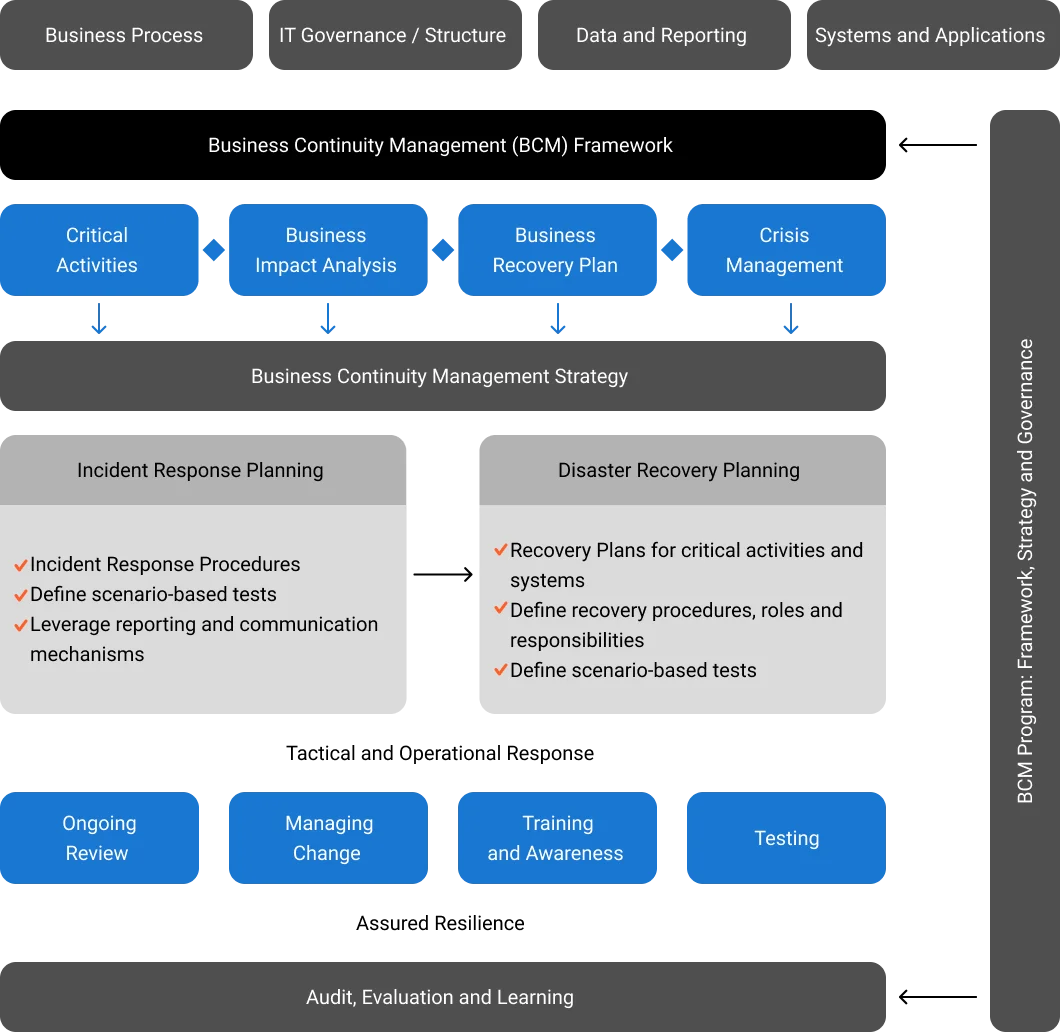CISO Online™ is your trusted partner in safeguarding business operations with our advanced Business Continuity and Disaster Recovery (BCDR) solutions. Our expert team ensures that your digital assets are fortified against potential disruptions, implementing cutting-edge BCDR measures for a swift and effective recovery in case of unforeseen events.
Choose CISO Online for a worry-free approach to business resilience

On July 19, 2024, a flawed software update in CrowdStrike Falcon’s channel file triggered widespread Windows system crashes, resulting in the notorious Blue Screen of Death (BSOD). This incident severely disrupted critical infrastructure globally, affecting everything from airline operations to public transit systems, and highlighted the cascading effects that software vulnerabilities can have on essential services.
Global COVID-19 Pandemic: The pandemic disrupted supply chains globally, underscoring the necessity for adaptable and comprehensive contingency plans to manage such unprecedented crises effectively.

Are you a business owner, organisation, or government entity grappling with uncertainty about how to ensure business continuity in the face of potential disasters? At CISO Online™ , we understand the challenges you face.
Our mission is to alleviate that burden by offering tailored Business Continuity and Disaster Recovery (BCDR) solutions designed to safeguard your operations.


On July 19, 2024, a flawed software update in CrowdStrike Falcon’s channel file triggered widespread Windows system crashes, resulting in the notorious Blue Screen of Death (BSOD). This incident severely disrupted critical infrastructure globally, affecting everything from airline operations to public transit systems, and highlighted the cascading effects that software vulnerabilities can have on essential services.
Our expert team conducts thorough audits to ensure your BCDR strategies comply with international standards, helping you meet regulatory requirements and industry expectations.
By identifying gaps in your current plans, we provide targeted enhancements to fortify your resilience, minimising downtime and stabilising operations quickly during disruptions.
We craft detailed BCP and DR plans tailored to your organisation’s specific needs, ensuring comprehensive coverage of all critical functions and systems.
Our extensive training sessions and awareness programs ensure that your team is prepared and well-versed in executing BCP and DR protocols effectively.
Through desktop and tabletop exercises, we test the effectiveness of your plans in simulated scenarios, ensuring that your team can respond swiftly and efficiently in real situations
Continuous Improvement: We believe in the ongoing enhancement of your BCDR strategies. Our continuous improvement processes ensure that your plans evolve in line with changing risks and business requirements
Maintenance and Continual Improvement

Our approach is structured around a comprehensive framework that integrates strategic business continuity, crisis management, and recovery solutions. As shown in the diagram below, we focus on critical activities, incident response planning, and continuous improvement to ensure that your business is resilient in the face of disruptions.
With CISO Online™, your business is not just prepared; it’s primed to thrive in the face of adversity. Let us help you build a resilient future.
BCDR is a comprehensive approach that combines business continuity planning (BCP) and disaster recovery planning (DRP) to ensure an organisation can continue operating and recover quickly after a disaster or disruption.
BCDR helps organisations minimize downtime, protect data, maintain customer trust, comply with regulations, and ensure long-term survival in the event of a disaster.
Key components include risk assessment, business impact analysis, recovery strategies, plan development, testing and exercises, communication plans, and continuous improvement.
Identify potential threats, assess the likelihood and impact of each threat, and prioritize risks based on their potential to disrupt business operations.
RTO is the maximum acceptable amount of time to restore a function after a disruption. RPO is the maximum acceptable amount of data loss measured in time.
Develop recovery strategies, document step-by-step procedures, assign roles and responsibilities, establish communication plans, and create a plan for testing and updating the BCDR plan regularly.
A BCDR plan should be tested at least annually, but more frequent testing is recommended for critical systems or during significant organisational changes.
Types of tests include tabletop exercises, walk-throughs, simulations, and full-scale drills.
Develop a communication plan that includes contact lists, predefined messages, communication channels, and roles and responsibilities for disseminating information.
Technology is critical for data backup and recovery, communication, remote work capabilities, and automating recovery processes.
Best practices include regular backups, storing backups in multiple locations (including offsite or in the cloud), encrypting backup data, and periodically testing backup restoration.
Regularly review and update the plan to reflect changes in business processes, technology, personnel, and external threats. Conduct periodic training and testing.
Cloud computing offers scalable, cost-effective solutions for data backup, disaster recovery, and business continuity, with benefits such as remote access, redundancy, and rapid deployment.
Assess third-party vendors’ BCDR capabilities, include BCDR requirements in contracts, and establish communication and coordination plans with key vendors.
Implement an incident response plan, isolate affected systems, restore data from backups, conduct a root cause analysis, and strengthen security measures to prevent future attacks.
Common challenges include lack of resources, inadequate testing, insufficient management support, outdated plans, and failure to integrate BCDR with overall business strategy.
There are several types of Disaster Recovery (DR) strategies that organisations can implement based on their specific needs and requirements:
1- Backup and Restore:
This involves regularly backing up data to a secondary storage location and restoring it in case of data loss or corruption. It's typically used for non-critical data and applications with longer recovery time objectives (RTOs) and recovery point objectives (RPOs).
2- Cold DR:
Cold Disaster Recovery (DR) in the cloud involves storing/replicating primary site data and infrastructure configurations in a dormant state, usually in an offline or powered-off state, until they're required for recovery. Unlike hot DR, where resources are continuously running and ready for immediate failover, cold DR relies on manual intervention (until and unless fully automated with scripts and logics) to activate resources and restore operations in the event of a disaster. This typically results in longer recovery times as resources need to be provisioned, data needs to be restored, and systems need to be brought online. Cold DR is often chosen for its cost-effectiveness and suitability for less critical workloads, where longer downtime is acceptable in exchange for lower operational costs.
3- Warm DR
A Warm Disaster Recovery (DR) in the cloud is an intermediate approach between cold and hot DR. In a warm DR setup, standby resources are partially active, meaning they're provisioned and configured but not actively processing workloads. These resources are in a semi-dormant state, ready to be quickly activated and brought online when needed. This allows for faster recovery times compared to cold DR since resources don't need to be fully provisioned from scratch. However, warm DR may still require manual intervention or automation to fully transition to operational status, resulting in a slightly longer recovery time compared to hot DR. Warm DR strikes a balance between cost-effectiveness and recovery speed, making it suitable for workloads that require a quicker recovery but can tolerate a short downtime window.
4- Hot DR:
Hot Disaster Recovery (DR) in the cloud is the highest level of readiness for disaster scenarios. In a hot DR setup, standby resources are fully active and running in parallel with primary production systems, constantly synchronized and ready to take over instantly in the event of a disaster. This involves real-time or near-real-time replication of data and configurations to the standby environment. When a disaster occurs, failover to the hot standby resources is automatic and seamless, with minimal to no interruption in service. Hot DR offers the fastest recovery times and highest level of availability but comes at a higher cost due to the continuous operation of redundant resources. It's typically used for mission-critical workloads where even the slightest downtime is unacceptable.

